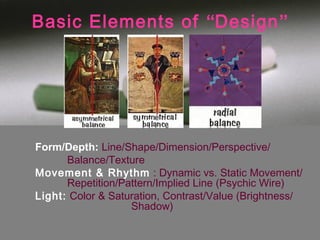
Basic elements of_color
- 1. Basic Elements of “Design” Form/Depth: Line/Shape/Dimension/Perspective/ Balance/Texture Movement & Rhythm : Dynamic vs. Static Movement/ Repetition/Pattern/Implied Line (Psychic Wire) Light: Color & Saturation, Contrast/Value (Brightness/ Shadow)
- 2. Mood… Black & White and monochromatic colors can lend a dreamy, thoughtful or reflective state. Transparent layering also romance or dreamlike contemplation.
- 3. Color Impact & Mood • Red: Action, aggression/ assertiveness/danger • Yellow: Demands attention; high readability • Green: Symbol of health & prosperity • Blue: Tranquility, stability • Black: Sophistication • Orange: Evokes “edibility” • Purple: Risk-taking
- 4. Red Hot. Red Hot. Advertisers use red to attract customers’ attention. Consumers are attracted to red because it awakens in them feelings of warmth, passion and sensuality.
- 5. Blue Period. Corporate advertisers love blue. USA Today says, ”The ad business is feeling blue— literally.” Blue is the USA's favorite color The use of blue gets consumers to open up to the message. Blue suggests upscale elegance. Blue also represents technology and the future.
- 6. General Mental Direct Objective Subjective Color Appearance Associations Associations Associations Impressions danger, Christmas, 4th intensity, brilliant, Hot, fire, of July, passionate, Red rage, intense,opaque,dry heat, blood Valentine's exciting active fierceness Day, Mother's Day, flag Warm, jovial, lively, hilarity, bright, luminous, Halloween, Orange metallic, energetic, exuberance, glowing Thanksgiving autumnal forceful satiety sunny, cheerful, high spirit, Yellow incandescent, sunlight caution inspiring, vital, health radiant celestial quieting, ghastliness, cool, nature, clear, St. Green clear, moist refreshing, disease, water Patrick's Day peaceful terror, guilt subduing, gloom, cold, sky, melancholy, Blue transparent, wet service, flag fearfulness, water, ice contemplative, furtiveness sober dignified, cool, mist, deep, soft, mourning, pompous, loneliness, Purple darkness, atmospheric Easter mournful, desperation shadow mystic cleanliness, brightness of pure, clean, White spatial - light cool, snow Mother's Day, spirit, frank, youthful flag normality funeral, neutral, ominous, negation of Black spatial - dark night, mourning deadly, spirit, death emptiness depressing
- 7. Basic Elements of “Color Theory” Hue Saturation Tints/Tones/Shades Warmth vs. Coolness Color Adjacency (Analogous Colors) Complementary Colors Monochromatic design
- 8. The Color Wheel Presents a logically arranged sequence of pure hues. A range of colors generated by mixing three beams of light. The 3 beams combined produce white light and are called primary colors (red, green, and blue). Isaac Newton developed the first color wheel in 1666. Since then artists have studied numerous variations of this concept.
- 9. Color Harmony How color behaves in relation to other colors is a complex area of color theory.
- 11. Cyan Subtracting light (black) Magenta Yellow K-BlacK
- 12. Red Green Blue Adding light (white)
- 15. such as red text on a blue background, Complements vibrate
- 18. RGB vs. CMYK • The RGB color model is an additive model in which red, green and blue (often used in additive light models) are combined in various ways to reproduce other colors. • The name of the model and the abbreviation "RGB" come from the three primary colors, Red, Green and Blue. These three colors should not be confused with the primary pigments of red, blue and yellow, known in the art world as "primary colors".
- 19. Color and CMYK • CMYK is a subtractive color model used in color printing. • This color model is based on mixing pigments of the following colors in order to make other colors: – C=cyan – M=magenta – Y=yellow – K=key (black). • The mixture of ideal CMY colors is subtractive (cyan, magenta, and yellow printed together on white result in black). CMYK works through light absorption. The colors that are seen are from the part of light that is not absorbed. In CMYK, magenta plus yellow produces red, magenta plus cyan makes blue and cyan plus yellow generates green.
